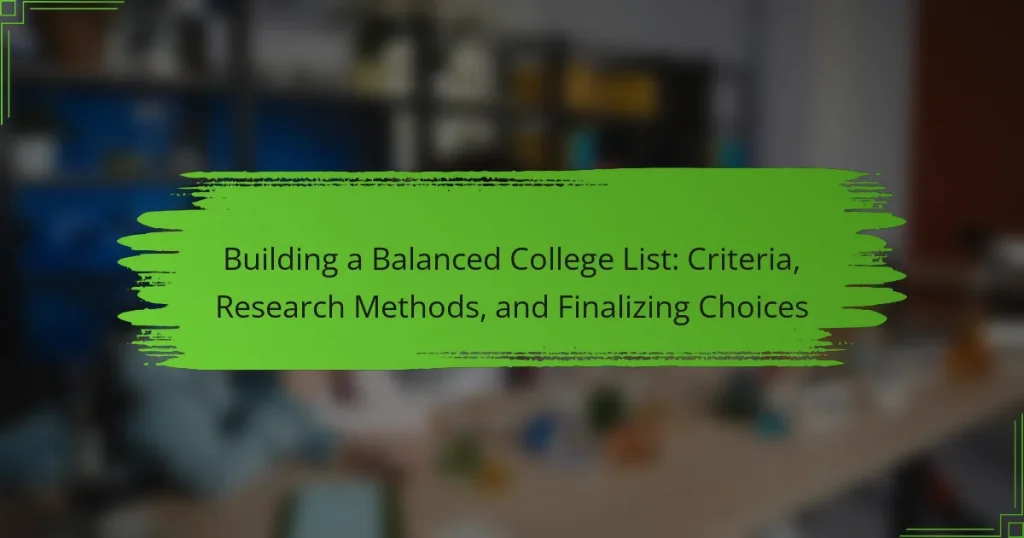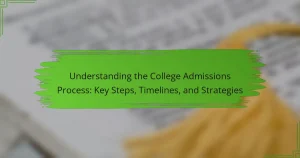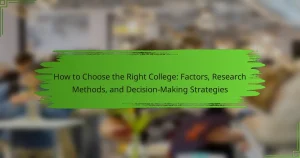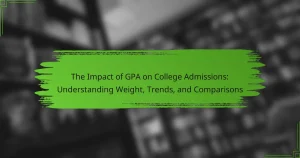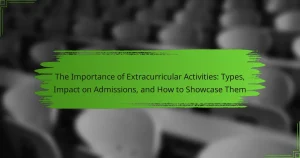
What is a Balanced College List?
A balanced college list includes a range of schools that vary in selectivity and fit. It typically consists of reach, match, and safety schools. Reach schools are those where admission is less likely due to high competition. Match schools align well with a student’s academic profile and interests. Safety schools are institutions where the student is very likely to be admitted. This approach helps students manage their college applications effectively. Research shows that a balanced list increases the chances of acceptance and satisfaction.
Why is it important to build a balanced college list?
Building a balanced college list is crucial for maximizing admission chances and ensuring a good fit. A balanced list typically includes a mix of reach, match, and safety schools. This approach helps students avoid overwhelming disappointment if they only apply to highly competitive institutions. Research indicates that students with a well-rounded list are more likely to receive multiple acceptance offers. Furthermore, a balanced list allows for diverse options in terms of academic programs, campus culture, and financial aid. By considering various factors, students can make informed decisions that align with their goals and preferences. This strategy ultimately enhances the overall college experience and future opportunities.
What are the key components of a balanced college list?
A balanced college list includes a range of safety, match, and reach schools. Safety schools are institutions where a student’s academic credentials exceed the average admitted student profile. Match schools align closely with a student’s academic qualifications and admission chances. Reach schools are institutions that may be more competitive than a student’s profile suggests.
In addition, diversity in college types is essential. This includes public, private, liberal arts, and specialized institutions. Geographic diversity also plays a role in creating a balanced list. Students should consider schools across various locations to expand opportunities.
Lastly, financial considerations are crucial. Students must evaluate the cost of attendance and available financial aid options. This ensures affordability and reduces financial stress.
How does a balanced college list impact college admissions?
A balanced college list positively impacts college admissions by increasing the likelihood of acceptance. A well-rounded list includes a mix of reach, match, and safety schools. This strategy helps students manage application stress and expectations. Research shows that students with balanced lists are more likely to receive multiple offers. According to the National Association for College Admission Counseling, students applying to a range of schools experience better outcomes. A balanced college list also allows for more informed decision-making. This approach encourages students to evaluate schools based on fit rather than prestige alone. Ultimately, a balanced list enhances students’ chances of finding a suitable college match.
What criteria should be considered when building a college list?
When building a college list, consider criteria such as academic programs, location, size, and cost. Academic programs should align with your intended major or field of study. Location impacts lifestyle and accessibility to home. Size affects campus culture and class experience. Cost includes tuition, fees, and potential financial aid. Additionally, consider campus resources, extracurricular opportunities, and institutional reputation. Each of these factors plays a critical role in the overall college experience.
How do academic programs influence college selection?
Academic programs significantly influence college selection by aligning students’ interests and career goals with available majors. Students often prioritize institutions that offer strong programs in their desired fields. For instance, a student interested in engineering will seek colleges renowned for their engineering departments. The reputation of academic programs can impact perceived value and job prospects after graduation. Research indicates that 70% of students consider program strength as a top factor in their college choice. Additionally, specialized programs, such as honors or dual-degree options, can attract students looking for unique educational experiences. Therefore, the availability and quality of academic programs play a crucial role in shaping students’ college decisions.
What role do campus culture and student life play in choosing colleges?
Campus culture and student life significantly influence college selection. Students often seek environments that align with their values and interests. A vibrant campus culture can enhance academic experiences and personal growth. Factors such as diversity, extracurricular activities, and social events contribute to this culture. Research shows that 70% of students prioritize campus atmosphere when choosing a college. Engaging student life fosters community and belonging, impacting retention rates. Additionally, a supportive campus culture can lead to higher academic performance. Overall, campus culture and student life are crucial in determining student satisfaction and success.
Why is financial consideration crucial in building a college list?
Financial consideration is crucial in building a college list because it directly impacts affordability and student debt levels. Students must evaluate tuition costs, fees, and living expenses associated with each institution. Financial aid packages and scholarships can significantly reduce the overall cost of attendance. According to the College Board, the average tuition and fees at public four-year institutions are over $10,000 for in-state students and nearly $27,000 for out-of-state students. Additionally, understanding the return on investment is essential; graduates from higher-cost institutions may not always secure higher salaries. Thus, incorporating financial factors ensures that students choose colleges that align with their financial situation and long-term goals.

What research methods can be used to create a college list?
Research methods to create a college list include surveys, interviews, and online research. Surveys can gather data from current students about their experiences. Interviews with college advisors provide personalized insights. Online research involves exploring college websites, rankings, and forums. Additionally, college fairs offer direct interaction with representatives. Prospective students can also utilize social media for community feedback. Analyzing academic programs and campus culture is essential. These methods ensure a comprehensive understanding of potential colleges.
How can online resources assist in researching colleges?
Online resources assist in researching colleges by providing accessible information on various aspects of higher education. They offer detailed data on college programs, admission requirements, and campus life. Websites like College Board and Niche compile rankings and reviews from students. These platforms also feature tools for comparing colleges based on criteria like location, size, and cost. Additionally, social media groups and forums allow prospective students to connect with current students. This interaction can provide firsthand insights into the college experience. Online resources often include virtual campus tours, which help students visualize the environment. Overall, these resources streamline the research process and enhance informed decision-making.
What are the most reliable websites for college information?
The most reliable websites for college information include College Board, U.S. News & World Report, and Niche. College Board provides comprehensive data on college admissions, standardized tests, and financial aid. U.S. News & World Report ranks colleges based on various criteria, offering insights into academic quality. Niche offers student reviews and detailed profiles of colleges, including campus life and academics. Each site is widely recognized for its accuracy and depth of information.
How can social media and forums provide insights into colleges?
Social media and forums can provide insights into colleges by facilitating real-time discussions and sharing experiences. Students and alumni often post reviews, tips, and personal stories about their college experiences. This information can reveal the campus culture, academic rigor, and social opportunities available at various institutions. For example, platforms like Reddit have dedicated college threads where users discuss specific colleges in detail. Additionally, social media sites allow prospective students to connect with current students for firsthand accounts. These platforms also enable users to ask questions and receive immediate feedback, enhancing the research process. Overall, the collective knowledge shared on these platforms can be invaluable for making informed college choices.
What is the significance of college visits in the research process?
College visits are significant in the research process as they provide firsthand experience of a campus. These visits allow prospective students to assess the environment and culture of the institution. Interactions with current students and faculty during visits can offer insights into academic programs. Observing facilities and resources helps students evaluate whether they meet their needs. Additionally, college visits can clarify the overall vibe and community feel of the campus. Research indicates that students who visit colleges are more likely to make informed decisions about their applications. According to a study by the National Association for College Admission Counseling, 73% of students found campus visits influential in their college choice.
How can prospective students make the most of campus visits?
Prospective students can make the most of campus visits by preparing in advance. They should research the college’s programs and culture before arriving. Creating a list of questions to ask current students and faculty is beneficial. Attending an information session can provide valuable insights. Taking a guided tour helps in understanding the campus layout and facilities. Engaging with student organizations showcases campus life. Observing interactions among students can reveal the social environment. Following up with notes after the visit aids in comparison with other colleges. These actions enhance the overall campus visit experience.
What questions should students ask during college tours?
Students should ask specific questions during college tours to gather essential information. They can inquire about academic programs and majors offered. Understanding class sizes and student-to-faculty ratios is important for learning environments. Students should also ask about campus resources such as libraries and study centers. Inquiring about extracurricular activities and clubs can help gauge campus life. It’s beneficial to ask about housing options and costs. Students should also learn about internship opportunities and career services available. Understanding financial aid and scholarship options is crucial for budgeting. Finally, students should ask about the overall campus culture and student support services.
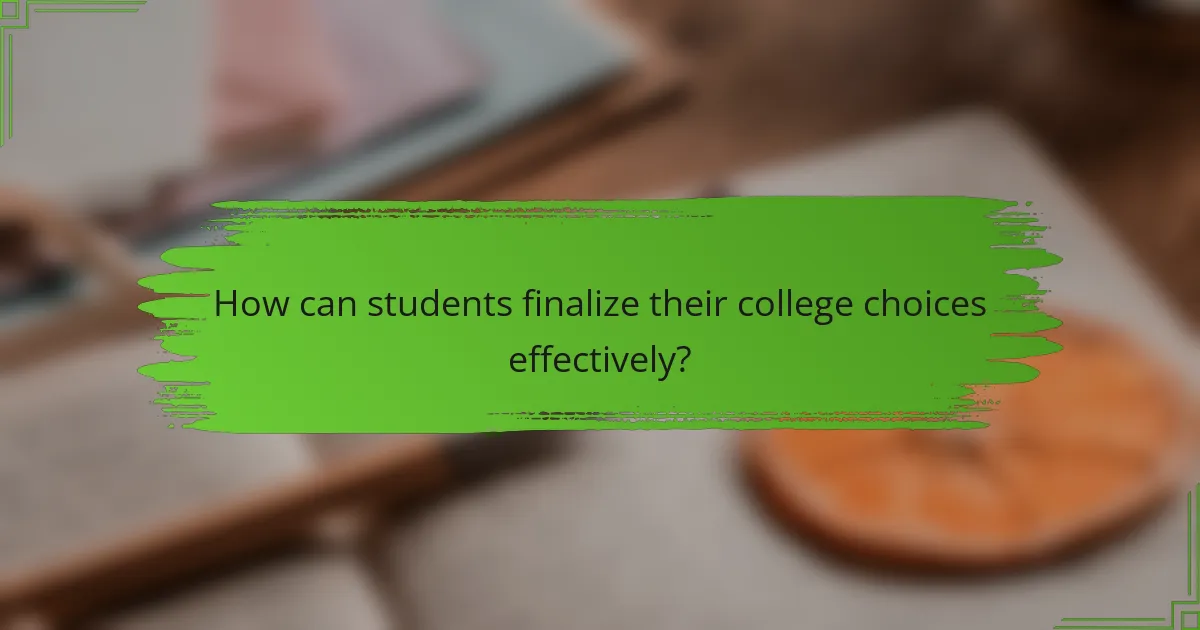
How can students finalize their college choices effectively?
Students can finalize their college choices effectively by evaluating their priorities and conducting thorough research. They should identify key factors such as academic programs, campus culture, and financial aid options. Creating a pros and cons list for each college can help clarify their preferences. Visiting campuses provides firsthand experience and insight into the environment. Engaging with current students and alumni can offer valuable perspectives. Setting deadlines for applications and decisions ensures a structured approach. Finally, trusting their instincts and feelings about each college is essential in making the final choice.
What strategies can help in narrowing down college options?
Identify key factors that influence college choice. These factors include location, size, academic programs, and campus culture. Research potential colleges using online resources and college guides. Attend college fairs and information sessions to gather more information. Create a pros and cons list for each college to evaluate them systematically. Visit campuses to experience the environment firsthand. Consult with current students or alumni for insights into their experiences. Narrow down options based on how well each college aligns with personal goals and preferences.
How should students evaluate their final choices against their criteria?
Students should evaluate their final choices by systematically comparing each option against their established criteria. This involves creating a checklist based on their priorities, such as academic programs, campus environment, and financial considerations. Students can score each choice on a scale to quantify how well it meets their criteria. Analyzing the scores helps in identifying which options align best with their goals. Additionally, students should consider seeking input from trusted advisors or peers. This collaborative feedback can provide new perspectives. Finally, reviewing any available data or statistics about each institution can reinforce their decision-making process.
What factors should be considered in making the final decision?
Factors to consider in making the final decision include academic programs, location, and financial aid. Academic programs should align with the student’s career goals and interests. Location impacts lifestyle, commute, and access to opportunities. Financial aid availability influences affordability and debt levels. Campus culture affects social life and student satisfaction. Admission rates provide insight into competitiveness. Lastly, support services like tutoring and counseling contribute to academic success. Collectively, these factors ensure a well-rounded decision that fits the student’s needs and aspirations.
What common mistakes should be avoided when finalizing a college list?
Common mistakes to avoid when finalizing a college list include not considering fit, overlooking financial factors, and relying solely on rankings. Failing to assess personal preferences can lead to a poor match with colleges. Ignoring the total cost of attendance can result in financial strain. Additionally, focusing only on popular or highly ranked schools may overlook institutions that align better with individual goals. Not visiting campuses can prevent students from gaining a true sense of the environment. Lastly, neglecting to seek input from trusted advisors can limit valuable perspectives on college choices.
How can over-reliance on rankings affect decision-making?
Over-reliance on rankings can lead to misguided decision-making. Individuals may prioritize institutions based solely on their position in rankings. This can overshadow other critical factors like program quality, campus culture, and personal fit. Rankings often emphasize metrics that may not align with individual goals. For example, a school ranked highly for research may not offer strong undergraduate teaching. Students could miss out on opportunities at lesser-known institutions that better meet their needs. Furthermore, rankings can create a herd mentality, pressuring students to choose popular options rather than exploring diverse choices. This can limit the exploration of unique programs that may offer a better educational experience.
Why is it important to balance aspiration with realistic options?
Balancing aspiration with realistic options is crucial for effective decision-making in college selection. Aspirations drive motivation and ambition, encouraging students to aim high. However, unrealistic expectations can lead to disappointment and frustration. Research shows that students who set achievable goals are more likely to succeed. A balanced approach allows students to explore a range of colleges that align with their academic profiles and financial situations. This strategy enhances the likelihood of acceptance and satisfaction with their choices. Ultimately, a realistic balance fosters a positive college experience and academic success.
What are some best practices for building a balanced college list?
To build a balanced college list, start by categorizing schools into three groups: reach, match, and safety. Reach schools are those where admission is less likely due to high selectivity. Match schools are those where a student’s qualifications closely align with the school’s average admitted student profile. Safety schools are those where a student’s qualifications exceed the school’s average, ensuring a higher likelihood of acceptance.
Next, consider factors such as academic programs, campus culture, location, and financial aid. Research each school’s offerings and environment to ensure they align with personal goals and preferences. Utilize resources like college rankings and student reviews to gather insights.
Additionally, aim for a diverse range of institutions to enhance options. This diversity can include different types of colleges, such as public, private, liberal arts, and community colleges. Finally, involve family and educators in the process for additional perspectives and advice. Following these practices ensures a well-rounded approach to college selection, increasing the chances of finding the right fit.
How can students involve their families in the decision-making process?
Students can involve their families in the decision-making process by facilitating open discussions about college choices. They should share their research findings with family members. This includes discussing potential colleges, programs, and criteria for selection. Students can ask for input on their preferences and priorities. Family members can provide insights based on their experiences and values. Organizing family meetings to review options can enhance collaboration. Additionally, students can encourage family members to participate in campus visits. Engaging families in this way fosters support and shared understanding throughout the decision-making process.
What tools and resources can assist in organizing college options?
College planning tools and resources can significantly aid in organizing college options. Online platforms like College Board and Niche provide comprehensive databases of colleges. These platforms allow users to filter schools based on criteria such as location, size, and programs offered. Additionally, tools like Common App streamline the application process for multiple colleges. College search apps, such as Cappex and Unigo, offer personalized recommendations based on student preferences. Furthermore, virtual campus tours and college comparison tools help visualize options. Finally, academic counseling services provide expert guidance tailored to individual student needs.
Building a balanced college list is essential for students to effectively manage their college applications and enhance their chances of acceptance. The article outlines the importance of including reach, match, and safety schools, along with key criteria such as academic programs, campus culture, and financial considerations. It also discusses research methods, including online resources and campus visits, to gather insights about potential colleges. Additionally, the article emphasizes best practices for finalizing choices while avoiding common mistakes, ensuring that students make informed decisions aligned with their aspirations and realistic options.
